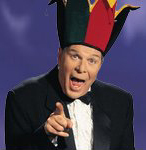Each week in this space, I strive to go the whole nine yards to entertain and enlighten you about our glorious, uproarious, courageous, contagious, stupendous, end-over-endous English language.
But what is the source of the phrase the whole nine yards, which means "the whole shootin' match," "whole hog," "the whole ball of wax"?
The fact that the whole nine yards did not enter popular use until the late 1960s renders dubious the nautical theory that the expression refers to the nine sails on a three-square-masted rigger. Nor could the expression issue from football, in which a team must gain 10, not nine, yards to reach a first down. Equally unproven or downright fallacious are dozens of other etymological explanations, including the material to make a dress, bridal veil or Scottish kilt; the length of a machine-gun belt in World War II fighter planes; the height of a prison retaining wall and the volume of mined ore.
I favor the theory that the whole nine yards refers to the revolving barrels on the backs of concrete mixing trucks. These barrels held a volume of nine cubic yards (they're now 12 cubic yards) in the early 1960s, a fact that explains why I never heard the phrase when I was growing up in the 1950s. Emptying the entire contents was one humongous road job — and, in most states, illegal because the weight of such a load would exceed the per-axel limits.
As you can see, my explanations are never in the abstract — and always in the concrete.
Our English language means business, and it is a good time to think about words that have made the journey from commerce into our everyday parlance:
- acid test. In bygone days, wandering peddlers would buy and sell old gold. If the traveling salesman had the slightest doubt about the value of an item he wished to purchase, he would file a shallow groove in that piece and touch it with nitric acid. Color reactions from the acid would reveal the approximate gold content, and inferior metals would be decomposed by the treatment. This procedure was known as the acid test, and by extension, any exacting method designed to reveal hidden flaws has come to be known by this term.
- masterpiece. Commercial life in medieval times was organized by guilds and crafts. An English apprentice who wished to be recognized as a master, with the right to work without supervision, was required to submit some article of metal, wood, stone or leather. Like today's academic dissertations, the quality of the work determined the artisan's future, and it came to be known as a master piece.
- cut and dried. Certain herbs sold in herbalists' shops were prepared ahead of time and thus lacked the freshness of herbs newly picked. Since the early 18th century these herbs have been labeled cut and dried. It's easy to see how that phrase came to signify anything boring and lacking in spontaneity.
- millstone. When people say they feel they've been put through the mill, they echo a metaphor from the trade of milling. Grain fed to the jaws of a great stone mill is subjected to heavy and thorough grinding. By figurative extension, any person receiving rough treatment is said to be put through the mill. Related words and expressions include milling around, run-of-the-mill and millstone, a circular stone used for grinding, but now any heavy burden.
I hope that you feel I've gotten down to brass tacks about the business of business English. During the heyday of dry goods stores, brass tacks were driven into the sales counters to mark a quarter, half and full yard. Rather than holding up a bolt of piece goods and guessing the measurement, merchants would lay the swath on the counter and calculate accurately by getting down to brass tacks.
Comment by clicking here.
JWR contributor Richard Lederer is a language maven. More than a million of his books, which have been Book-of-the-Month Club and Literary Guild alternate selections, are in print. His latest work is Presidential Trivia: The Feats, Fates, Families, Foibles, and Firsts of Our American Presidents


 Contact The Editor
Contact The Editor
 Articles By This Author
Articles By This Author
